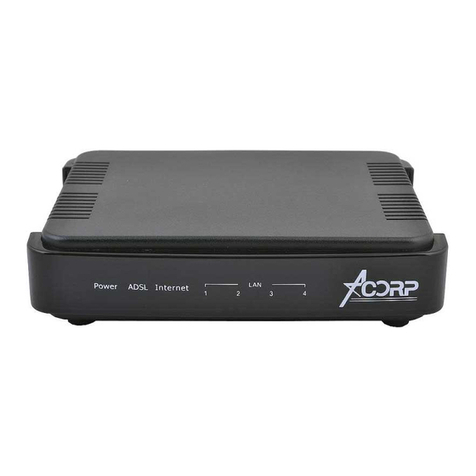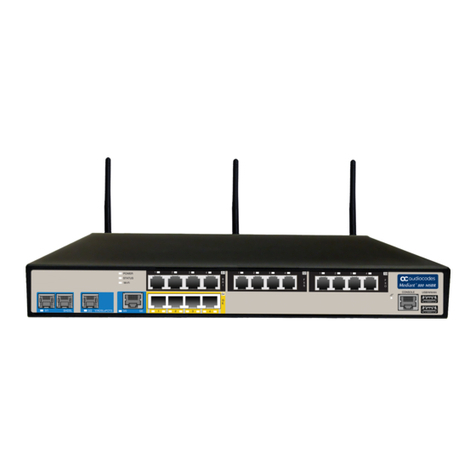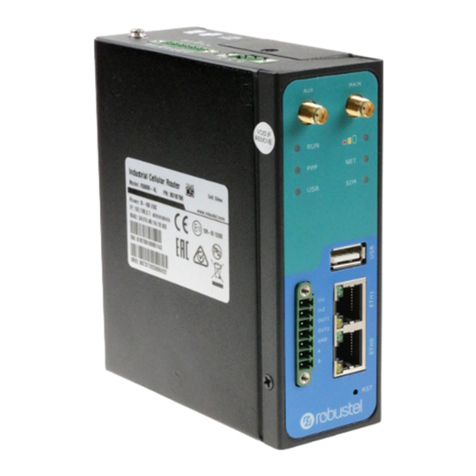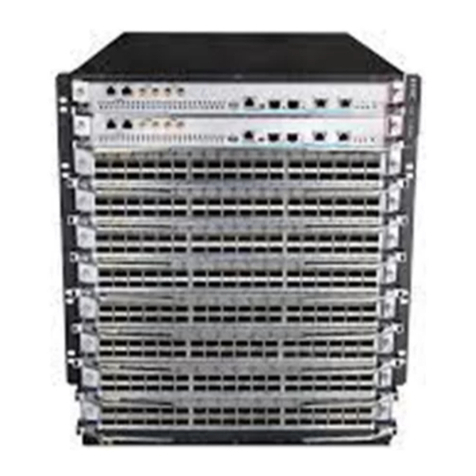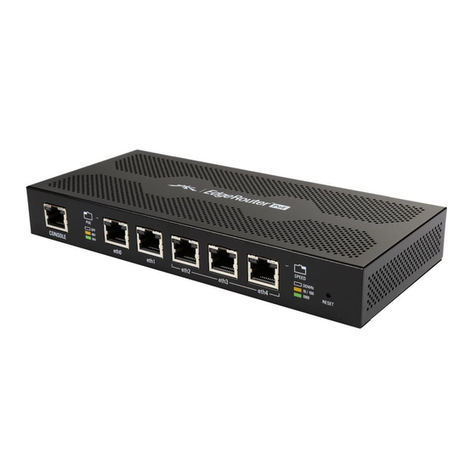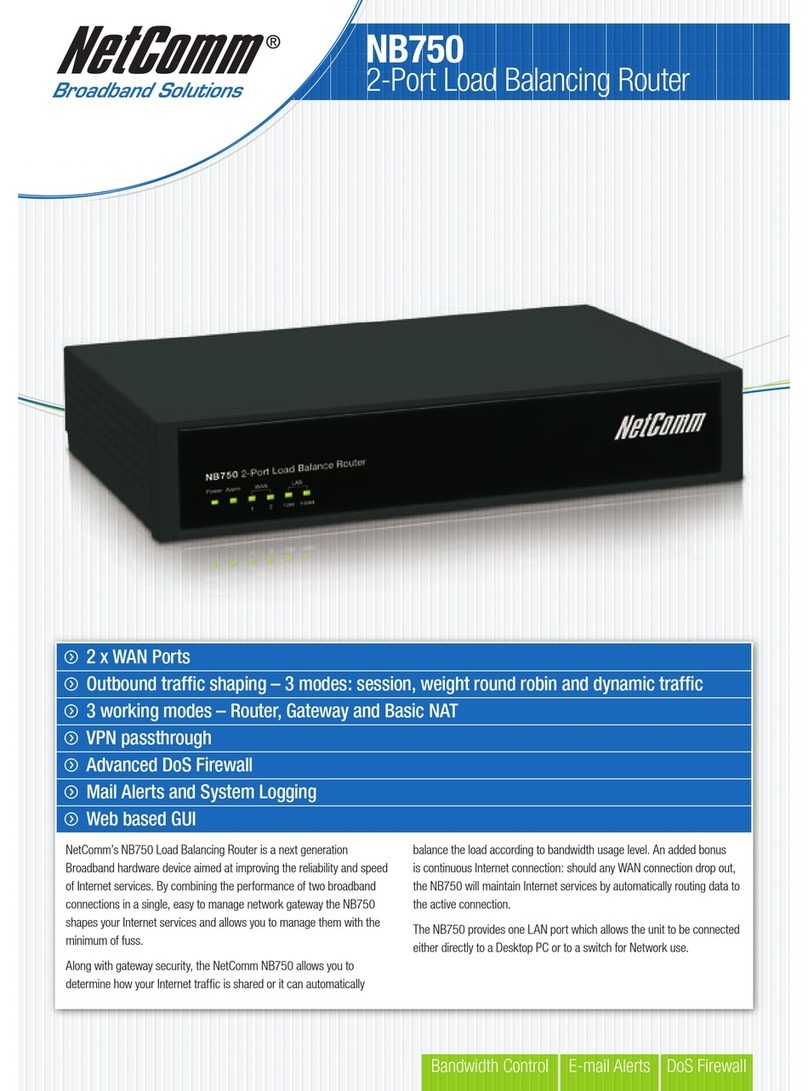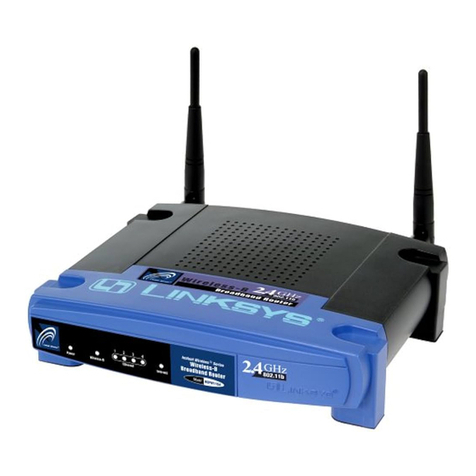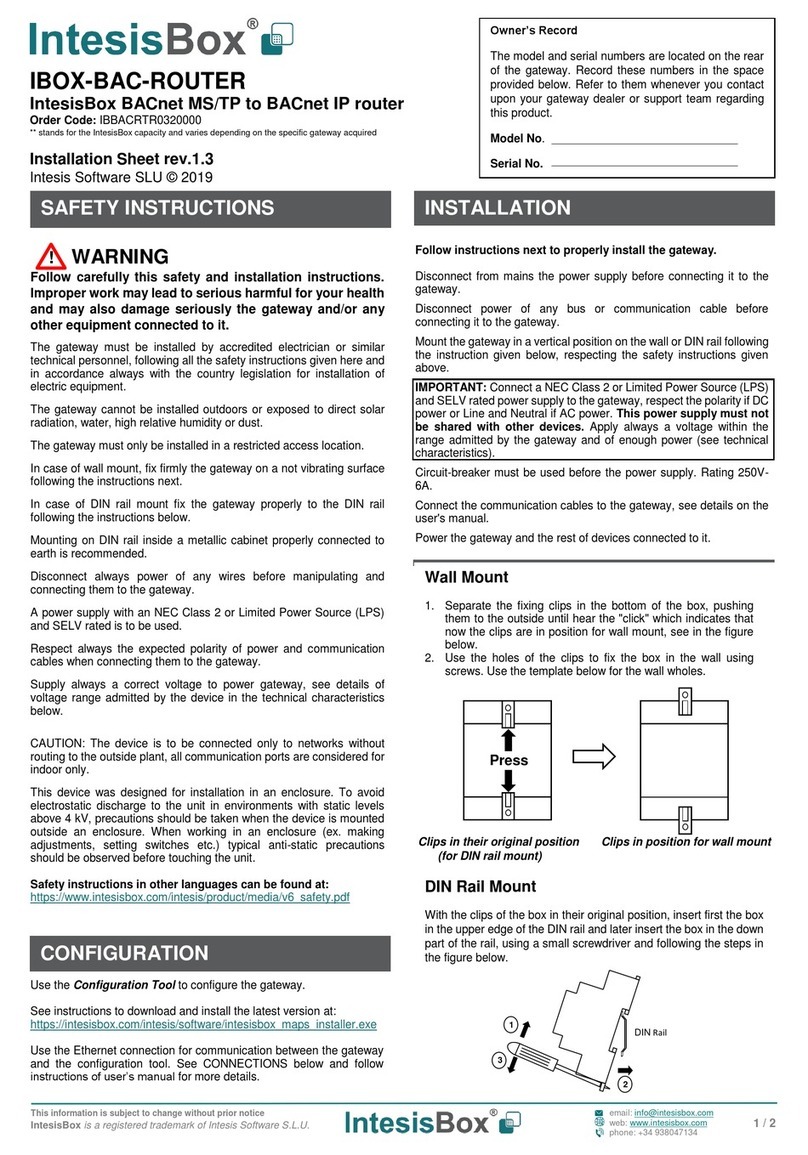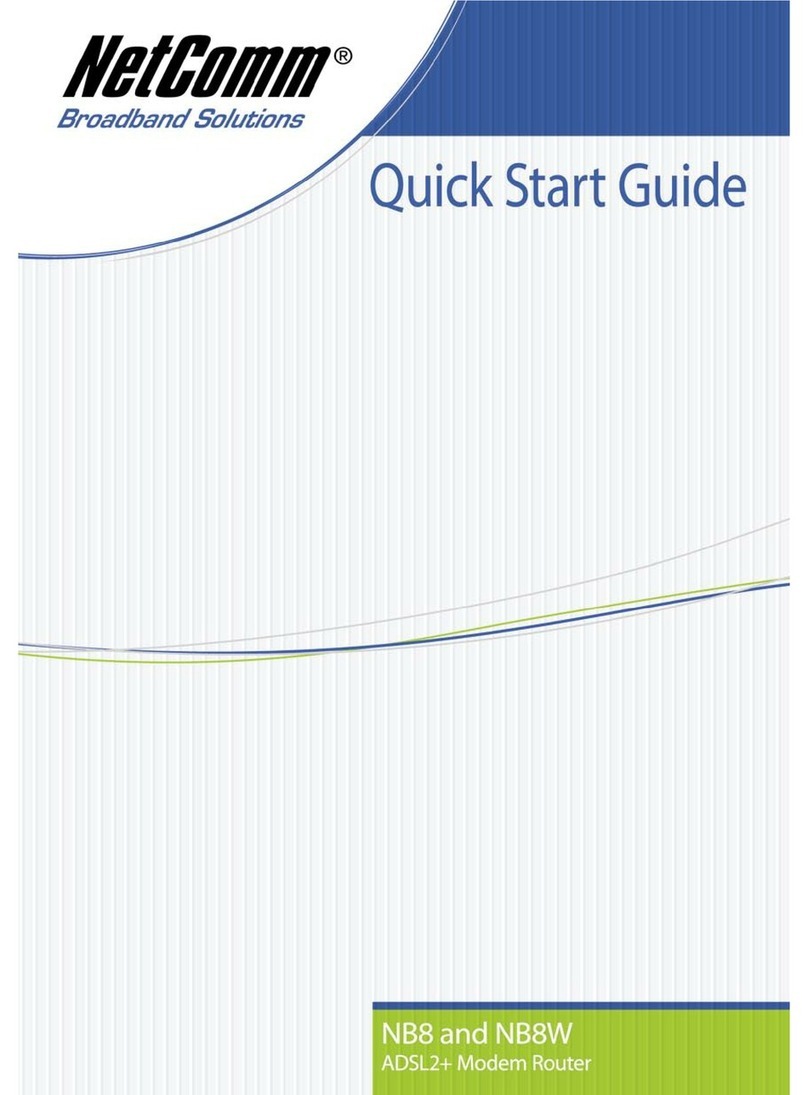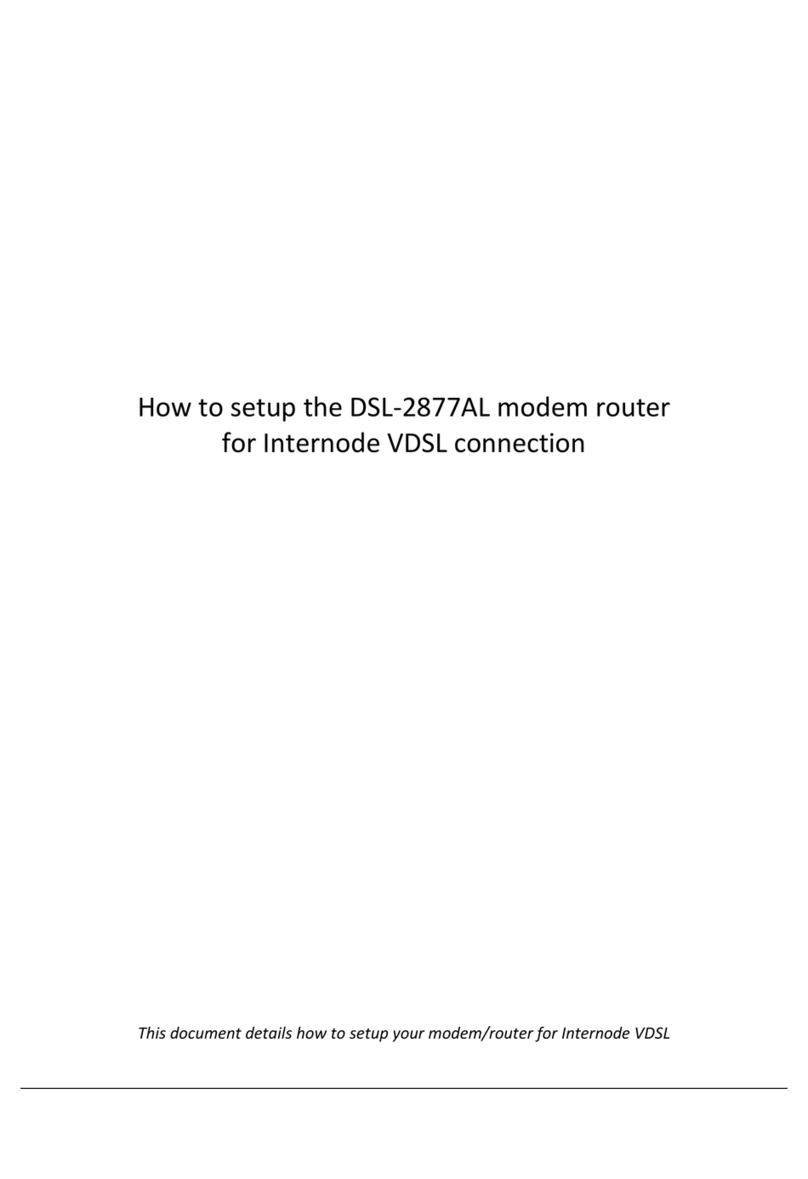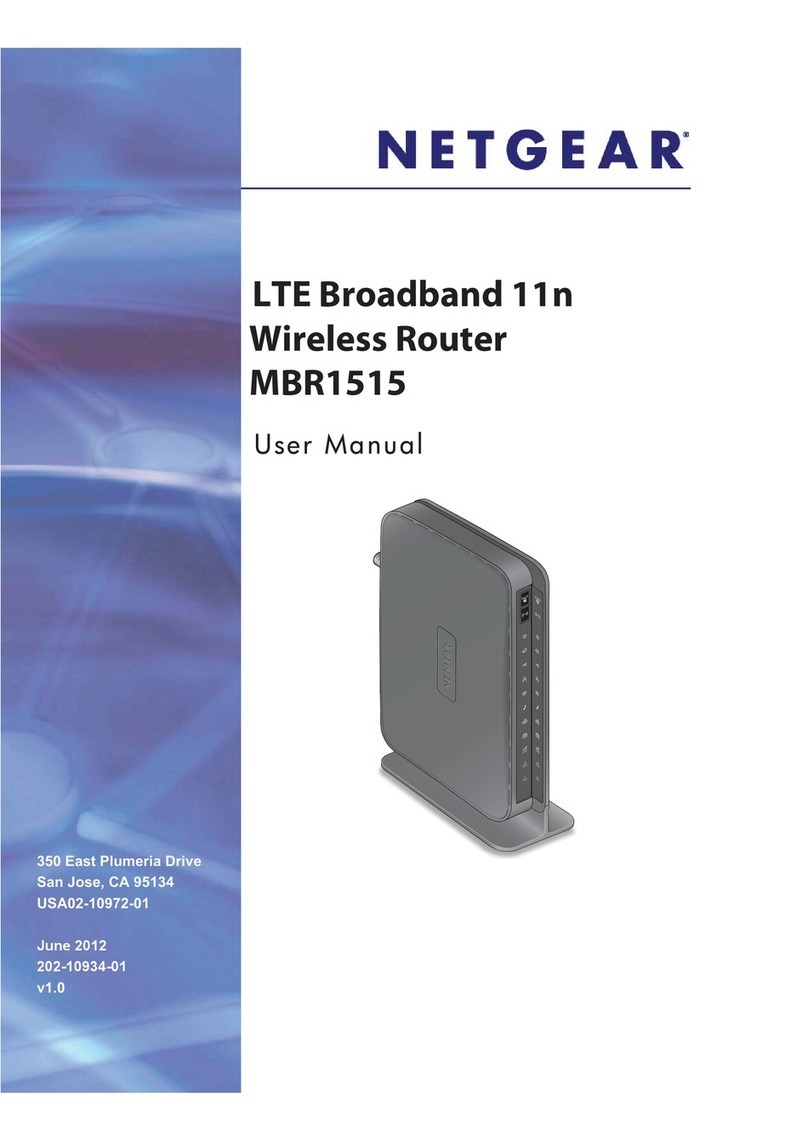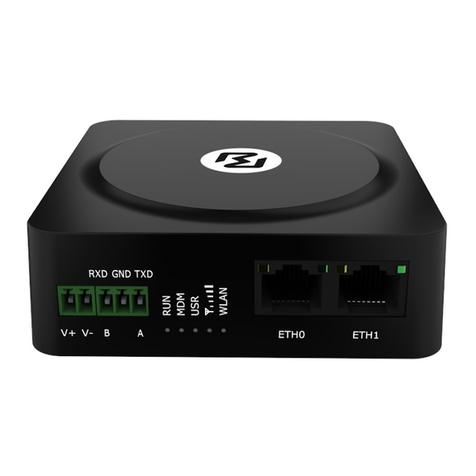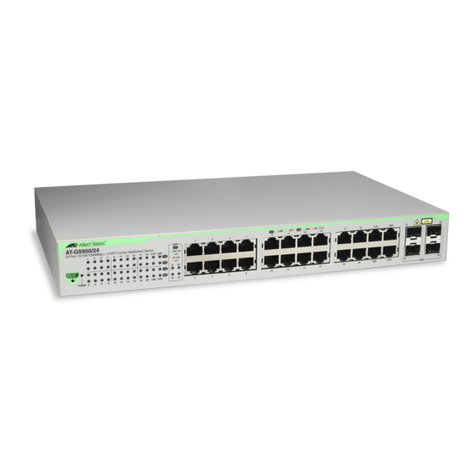Acorp Sprinter W422G User manual

Sprinter@ ADSL W422G (3.0)---------- User’s Manual
1
User’s Manual
Sprinter@ ADSL2+ WiFi ROUTER
W422G(3.0)
Version 1.0 en

2
Contents
1Introduction .............................................................................................................................................. 5
2System Overview ..................................................................................................................................... 5
2.1 Specifications.......................................................................................................................... 5
2.1.1 ADSL Standard............................................................................................................... 5
2.1.2 Wireless Features .......................................................................................................... 5
2.1.3 Software Features.......................................................................................................... 6
2.1.4 Management .................................................................................................................. 6
3Hardware Installation ............................................................................................................................... 7
3.1 Hardware Requirements......................................................................................................... 7
3.2 Hardware Setup Procedures .................................................................................................. 7
4Software Configuration............................................................................................................................. 8
4.1 LAN Configuration ................................................................................................................ 10
4.2 Wireless Configuration...........................................................................................................11
4.2.1 Basic Setting .................................................................................................................11
4.2.2 Advanced Settings ....................................................................................................... 12
4.2.3 Security ........................................................................................................................15
4.2.4 Access Control ............................................................................................................. 16
4.2.5 WDS.............................................................................................................................18
4.2.6 WPS .............................................................................................................................19
4.3 WAN Configuration ...............................................................................................................21
4.3.1 Channel Configuration ................................................................................................. 21
4.3.2 ATM Setting.................................................................................................................. 24
4.3.3 ADSL Setting................................................................................................................ 25
4.4 Services Configuration..........................................................................................................27
4.4.1 DHCP Mode ................................................................................................................. 27
4.4.2 DHCP Server Configuration ......................................................................................... 27
4.4.3 DHCP Relay Configuration .......................................................................................... 28
4.4.4 DNS Configuration ....................................................................................................... 29
4.4.4.1 DNS Server ......................................................................................................... 29
4.4.4.2 Dynamic DNS...................................................................................................... 30
4.4.5 Firewall Configuration .................................................................................................. 33
4.4.5.1 IP/Port Filtering.................................................................................................... 33
4.4.5.2 MAC Filtering....................................................................................................... 35
4.4.5.3 Port Forwarding................................................................................................... 37
4.4.5.4 DMZ..................................................................................................................... 38
4.4.5.5 URL Blocking....................................................................................................... 39

3
4.4.5.6 Domain blocking.................................................................................................. 41
4.4.6 IGMP Proxy Configuration ........................................................................................... 43
4.4.7 UPnP Configuration ..................................................................................................... 45
4.4.8 RIP Configuration......................................................................................................... 46
4.5 Advance Configuration ......................................................................................................... 47
4.5.1 Bridging ........................................................................................................................47
4.5.2 Routing.........................................................................................................................48
4.5.3 SNMP Configuration .................................................................................................... 51
4.5.4 Port Mapping................................................................................................................ 52
4.5.5 IP QoS..........................................................................................................................54
4.5.6 Remote Access ............................................................................................................ 55
4.6 Diagnostic ............................................................................................................................. 56
4.6.1 Ping .............................................................................................................................. 56
4.6.2 ATM Loopback ............................................................................................................. 57
4.6.3 ADSL............................................................................................................................58
4.6.4 Diagnostic Test............................................................................................................. 59
4.7 Admin.................................................................................................................................... 60
4.7.1 Commit/Reboot ............................................................................................................ 60
4.7.2 Backup/Restore............................................................................................................ 61
4.7.3 System Log .................................................................................................................. 63
4.7.4 Password ..................................................................................................................... 63
4.7.5 Upgrade Firmware ....................................................................................................... 64
4.7.6 ACL .............................................................................................................................. 65
4.7.7 Time Zone .................................................................................................................... 66
4.7.8 TR-069 Config.............................................................................................................. 67
4.8 Statistics................................................................................................................................ 69
4.8.1 Interfaces ..................................................................................................................... 69
4.8.2 ADSL............................................................................................................................69
5Channel Mode Configuration ................................................................................................................. 71
5.1 Bridge Mode ......................................................................................................................... 71
5.2 MER(Mac Encapsulating Routing) Mode ............................................................................. 72
5.3 PPPoE Mode ........................................................................................................................ 73
5.4 PPPoA Mode ........................................................................................................................ 74
5.5 1483 Routed Mode ............................................................................................................... 75
Appendices ..................................................................................................................................................... 76
Appendix A: Protocol Stacks.................................................................................................................... 76
5.5.1 A.1 1483 Bridged Model .............................................................................................. 76
5.5.2 A.2 1483 MER Model................................................................................................... 77

4
5.5.3 A.3 PPPoE Model ........................................................................................................ 78
5.5.4 A.4 PPPoA Model......................................................................................................... 79
5.5.5 A.5 1483 Routed Model ............................................................................................... 80
Appendix B: Mapping PVCs to VLANs.................................................................................................... 80

5
1 Introduction
W422G(3.0) is a high-speed ADSL2+ Ethernet/Wireless router that is specifically designed
to connect to the Internet and to directly connect to your local area network (LAN) via
high-speed 10/100 Mbps Ethernet, or wireless LAN (WLAN). The ADSL2+ modem is
compatible with the latest ADSL standards, including ADSL2 and ADSL2+, and supports
up to 24 Mbps downstream and 1.5 Mbps upstream to deliver true broadband speed and
throughput. The DSL router supports wireless 802.11b/g and the following security
protocols: WEP, WPA, WPA2, and 802.1x.
To ensure fully compatibility, the DSL device was tested with all major DSLAMs, and
support standard 10/100 Mbps Base-T Ethernet interface Auto MDI/MDIx 10/100 Switch
function allowing user easily to link to PC or other Switches/Hubs. The DSL device is an
idea solution for multi-users utilizing build-in channel mode (PPPoE/A, IPoA, IPoE), IP
routing, NAT functionalities sharing the ADSL link. The DSL device is also a perfect
solution for the residential users, it supports the users with bridge mode in host based
PPPoE Client.
2 System Overview
2.1 Specifications
2.1.1 ADSL Standard
ITU-T G.992.1(G.dmt)
ANSI T1.413 Issue 2
G.992.2 (G.lite)
G.994.1 (G.hs)
Auto-negotiating rate adaptation
ADSL2 G.dmt.bis (G.992.3)
ADSL2 G.lite.bis (G.992.4)
ADSL2+ (G.992.5)
2.1.2 Wireless Features
Compilant with IEEE 802.11 B/G
Up to 54 Mbps wireless operation rate
64/128 bits WEP for security
WPA support
ACL (MAC address Filtering)

6
2.1.3 Software Features
RFC-1483/2684 LLC/VC-Mux bridged/routed mode
RFC-1577 Classical IP over ATM
RFC-2516 PPPoE
RFC-2364 PPPoA
ITU-T 1.610 F4/F5 OAM send and receive loop-back
802.1d Spanning-Tree Protocol
DHCP Client/Server/Relay
NAT
RIP v1/v2
DNS Relay Agent
DMZ support
IGMP Proxy/Snooping
Stateful Packet Inspection
Protection against Denial of Service attacks
IP Packet Filtering
QoS
Dynamic DNS
UPnP support
2.1.4 Management
Web-based Configuration
Menu-driven Command-line Interpreter
Telnet Remote Management
SNMP v1/v2/Trap
Firmware upgrade through FTP, TFTP and HTTP
Configuration backup/restore
Diagnostic Tool

7
3 Hardware Installation
3.1 Hardware Requirements
A RTL867x demo board with RTL8185 WLAN card
12V DC power
RJ-45 Ethernet cable
RJ-11 ADSL line
COM Port cable (Optional)
3.2 Hardware Setup Procedures
1. Connect RJ-11 line from RTL867x to DSLAM.
2. Connect RJ-45 line from your PC to RTL867x Ethernet port.
3. Connect PC COM port to RTL867x COM port if you have COM port cable. You can
monitor the status of system and input control commands from PC’s HyperTerminal.
4. Connect the 12V DC power.

8
4 Software Configuration
The W422G(3.0) is an ADSL2+ wireless router. When you power on the device, the system
will boot up and connect to ADSL automatically. The system provides a PVC for bridge test
by default. The default configurations for the system are listed below.
LAN IP address: 192.168.1.1, NetMask:255.255.255.0
UART setting: 115200bps, 8 bits, no parity, 1 stop bit, no flow control.
VPI/VCI for ATM: 5/35.
ADSL Line mode: Auto-detect.
User can change settings via WEB browser. The following sections describe the set up
procedures.
Please set your PC’s Ethernet port as follow:
IP address: 192.168.1.XXX
NetMask:255.255.255.0
Access the Web Console:
Start your web browser.
Type the Ethernet IP address of the modem/router on the address bar of the browser.
Default IP address is 192.168.1.1.
The Enter Network Password dialog box appears. Type the user name and password
and then click OK.
Once you have connected to ADSL2+ router. You will see the status page.

9
This page displays the ADSL modem/router’s current status and settings. This information
is read-only except for the PPPoE/PPPoA channel for which user can connect/disconnect
the channel on demand. Click the “Refresh” button to update the status
Function buttons in this page:
Connect / Disonnect
The two buttons take effect only when PVC is configured as PPPoE/PPPoA mode. Click
Connect/Disconnect button to connect/disconnect the PPP dial up link.
.

10
4.1 LAN Configuration
This page shows the current setting of LAN interface. You can set IP address, subnet mask,
and IGMP Snooping for LAN interface in this page.
Fields in this page:
Field Description
IP Address The IP address your LAN hosts use to identify the device’s LAN port.
Subnet Mask LAN subnet mask.
IGMP Snooping Enable/disable the IGMP snooping function for the multiple bridged LAN ports.
Function buttons in this page:
Apply Changes
Click to save the setting to the configuration. New parameters will take effect after
save into flash memory and reboot the system. See section “Admin” for save details.
Undo
Discard your changes.

11
4.2 Wireless Configuration
This section provides the wireless network settings for your WLAN interface. The wireless
interface enables the wireless AP function for ADSL modem.
4.2.1 Basic Setting
This page contains all of the wireless basic settings. Most users will be able to configure
the wireless portion and get it working properly using the setting on this screen.
Fields in this page:
Field Description
Disable Wireless LAN
Interface
Check it to disable the wireless function for ADSL modem.
Band Select the appropriate band from the list provided to correspond with your network
setting.
Mode The selections are: AP or AP+WDS.
SSID The Service Set Identifier (SSID) or network name. It is case sensitive and must not
exceed 32 characters, which may be any keyboard character. The mobile wireless
stations shall select the same SSID to be able to communicate with your ADSL

12
modem (or AP).
Channel Number Select the appropriate channel from the list provided to correspond with your
network settings. You shall assign a different channel for each AP to avoid signal
interference.
Radio Power (mW) The maximum output power: 15mW, 30mW or 60mW.
Function buttons in this page:
Associated Clients
Click it will show the clients currently associated with the ADSL modem.
Apply Changes
Change the settings. New parameters will take effect after save into flash memory and
reboot the system. See section “Admin” for save details.
Reset
Discard your changes and reload all settings from flash memory.
4.2.2 Advanced Settings
This page allows advanced users who have sufficient knowledge of wireless LAN. These
setting shall not be changed unless you know exactly what will happen for the changes you
made on your DSL device.

13
Fields in this page:
Field Description
Authentication Type Open System: Open System authentication is not required to be successful while a
client may decline to authenticate with any particular other client.
Shared Key: Shared Key is only available if the WEP option is implemented. Shared
Key authentication supports authentication of clients as either a member of those
who know a shared secret key or a member of those who do not. IEEE 802.11
Shared Key authentication accomplishes this without the need to transmit the secret
key in clear. Requiring the use of the WEP privacy mechanism.
Auto: Auto is the default authentication algorithm. It will change its authentication
type automatically to fulfill client’s requirement.
Fragment Threshold This value should remain at its default setting of 2346. It specifies the maximum size
for a packet before data is fragmented into multiple packets. If you experience a high
packet error rate, you may slightly increases the “Fragment Threshold” value within
the value range of 256 to 2346. Setting this value too low may result in poor network
performance. Only minor modifications of this value are recommended.
RTS Threshold This value should remain at its default setting of 2347. Should you encounter

14
inconsistent data flow, only minor modifications are recommended. If a network
packet is smaller than the preset “RTS threshold” size, the RTS/CTS mechanism will
not be enabled. The ADSL modem (or AP) sends Request to Send (RTS) frames to
a particular receiving station and negotiates the sending of a data frame. After
receiving an RTS, the wireless station responds with a Clear to Send (CTS) frame to
acknowledge the right to begin transmission.
Beacon Interval The Beacon Interval value indicates the frequency interval of the beacon. Enter a
value between 20 and 1024. A beacon is a packet broadcast by the ADSL modem
(or AP) to synchronize the wireless network. The default is 100.
Data Rate The rate of data transmission should be set depending on the speed of your wireless
network. You should select from a range of transmission speeds, or you can select
Auto to have the ADSL modem (or AP) automatically use the fastest possible data
rate and enable the Auto-Fallback feature. Auto-Fallback will negotiate the best
possible connection speed between the AP and a wireless client. The default setting
is Auto.
Preamble Type The Preamble Type defines the length of the CRC (Cyclic Redundancy Check) block
for communication between the AP and mobile wireless stations. Make sure to select
the appropriate preamble type. Note that high network traffic areas should use the
short preamble type. CRC is a common technique for detecting data transmission
errors.
Broadcast SSID If this option is enabled, the device will automatically transmit their network name
(SSID) into open air at regular interval. This feature is intended to allow clients to
dynamically discover and roam between WLANs; if this option is disabled, the device
will hide its SSID. When this is done, the station cannot directly discover its WLAN
and MUST be configure with the SSID. Note that in a home Wi-Fi network, roaming
is largely unnecessary and the SSID broadcast feature serves no useful purpose.
You should disable this feature to improve the security of your WLAN.
Relay Blocking When Relay Blocking is enabled, wireless clients will not be able to directly access
other wireless clients.
Ethernet to Wireless
Blocking
When enabled, traffic between Ethernet and wireless interfaces are not allowed.
Function buttons in this page:
Apply Changes
Change the settings. New parameters will take effect after save into flash memory and
reboot the system. See section “Admin” for save details.
Reset

15
Discard your changes and reload all settings from flash memory.
4.2.3 Security
This screen allows you to setup the wireless security. Turn on WEP or WPA by using
encryption keys could prevent any unauthorized access to your WLAN.
Fields in this page:
Field Description
Encryption There are 4 types of security to be selected. To secure your WLAN, it’s strongly
recommended to enable this feature.
WEP: Make sure that all wireless devices on your network are using the same
encryption level and key. Click Set WEP Key button to set the encryption key.
WPA (TKIP): WPA uses Temporal Key Integrity Protocol (TKIP) for data encryption.
TKIP utilized a stronger encryption method and incorporates Message Integrity Code
(MIC) to provide protection against hackers.
WPA2 (AES): WPA2, also known as 802.11i, uses Advanced Encryption Standard
(AES) for data encryption. AES utilized a symmetric 128-bit block data encryption.
WAP2 Mixed: The AP supports WPA (TKIP) and WPA2 (AES) for data encryption.
The actual selection of the encryption methods will depend on the clients.

16
Use 802.1x
Authentication
Check it to enable 802.1x authentication. This option is selectable only when the
“Encryption” is choose to either None or WEP. If the “Encryption” is WEP, you need
to further select the WEP key length to be either WEP 64bits or WEP 128bits.
WPA Authentication
Mode
There are 2 types of authentication mode for WPA.
WPA-RADIUS: WPA RADIUS uses an external RADIUS server to perform user
authentication. To use WPA RADIUS, enter the IP address of the RADIUS server,
the RADIUS port (default is 1812) and the shared secret from the RADIUS server.
Please refer to “Authentication RADIUS Server” setting below for RADIUS setting.
The WPA algorithm is selected between TKIP and AES, please refer to “WPA cipher
Suite” below.
Pre-Shared Key: Pre-Shared Key authentication is based on a shared secret that is
known only by the parties involved. To use WPA Pre-Shared Key, select key format
and enter a password in the “Pre-Shared Key Format” and “Pre-Shared Key” setting
respectively. Please refer to “Pre-Shared Key Format” and “Pre-Shared Key” setting
below.
Pre-Shared Key
Format
PassPhrase: Select this to enter the Pre-Shared Key secret as user-friendly textual
secret.
Hex (64 characters): Select this to enter the Pre-Shared Key secret as hexadecimal
secret.
Pre-Shared Key Specify the shared secret used by this Pre-Shared Key. If the “Pre-Shared Key
Format” is specified as PassPhrase, then it indicates a passphrase of 8 to 63 bytes
long; or if the “Pre-Shared Key Format” is specified as PassPhrase, then it indicates
a 64-hexadecimal number.
Authentication RADIUS
Server
If the WPA-RADIUS is selected at “WPA Authentication Mode”, the port (default is
1812), IP address and password of external RADIUS server are specified here.
Function buttons in this page:
Apply Changes
Change the settings. New parameters will take effect after save into flash memory and reboot
the system. See section “Admin” for save details.
4.2.4 Access Control
This page allows administrator to have access control by enter MAC address of client
stations. When Enable this function, MAC address can be added into access control list
and only those clients whose wireless MAC address are in the access control list will be
able to connect to your DSL device (or AP).

17
Fields in this page:
Field Description
Wireless Access
Control Mode
The Selections are:
Disable
Disable the wireless ACL feature.
Allow Listed
When this option is selected, no wireless clients except those whose MAC
addresses are in the current access control list will be able to connect (to this
device).
Deny Listed
When this option is selected, all wireless clients except those whose MAC
addresses are in the current access control list will be able to connect (to this
device).
MAC Address Enter client MAC address and press “Apply Changes” button to add client MAC
address into current access control list.
Function buttons for the setting block:
Apply Changes

18
Click to add this entry into the Current Access Control List.
The Current Access Control List lists the client MAC addresses. Any wireless client with its MAC
address listed in this access control list will be able to connect to the device. You can select the
entries at the Select column and apply to the following function buttons.
Function buttons for the Current Access Control List:
Delete Selected
Delete the selected entries from the list.
Delete All
Flush the list.
4.2.5 WDS
Wireless Distribution System (WDS) is a system that interconnects BSS to build a premise
wide network. The DSL device supports the WDS protocol, which allows a point to point
link to be established between two APs. Only if you select AP+WDS mode on the Basic
Settings page, this WDS page can be configured.
Fields in this page:
Field Description

19
Enable WDS Check to enable the WDS function.
Add WDS AP This is where you enter the MAC address of the peer AP’s wireless interface that you
are connecting to.
Function buttons for this setting block:
Apply Changes
Click to add this entry into the Current WDS AP List.
The Current WDS AP List lists the peer MAC addresses of the WDS link. Any AP with its MAC
address listed in this WDS AP list may have a WDS link to the device. You can select the entries at
the Select column and apply to the following function buttons.
Function buttons for the Current WDS AP List:
Delete Selected
Delete the selected entries from the list.
Delete All
Flush the list.
4.2.6 WPS
Although home Wi-Fi networks have become more and more popular, users still have
trouble with the initial set up of network. This obstacle forces users to use the open security
and increases the risk of eavesdropping. Therefore, The Wi-Fi Protected Setup (WPS) is
designed to ease set up of security-enabled Wi-Fi networks and subsequently network
management (Wi-Fi Protected Setup Specification 1.0h.pdf, p. 8).
The largest difference between WPS-enabled devices and legacy devices is that users do
not need the knowledge about SSID, channel and security settings, but they could still surf
in a security-enabled Wi-Fi network.
This device supports Push Button method and PIN method for WPS. The following
sub-paragraphs will describe the function of each item. The webpage is as below.

20
Fields in this page:
Field Description
Disable WPS Check to disable the Wi-Fi protected Setup.
WPS Status When AP’s settings are factory default (out of box), it is set to open security and
un-configured state. “WPS Status” will display it as “UnConfigured”. If it already
shows “Configured”, some registrars such as Vista WCN will not configure AP. Users
will need to go to the “Backup/Restore” page and click “Reset” to reload factory
default settings.
Self-PIN Number “Self-PIN Number” is AP’s PIN. Whenever users want to change AP’s PIN, they
could click “Regenerate PIN” and then click “ Apply Changes”. Moreover, if users
want to make their own PIN, they could enter four-digit PIN without checksum and
then click “ Apply Changes”. However, this would not be recommended since the
registrar side needs to be supported with four-digit PIN.
Push Button
Configuration
Clicking this button will invoke the PBC method of WPS. It is only used when
A
P acts
as a registrar.
Client PIN Number It is only used when users want their station to join AP’s network. The length of PIN
is limited to four or eight numeric digits. If users enter eight-digit PIN with checksum
error, there will be a warning message popping up. If users insist on this PIN, AP will
take it.
Function buttons in this page:
Regenerate PIN
Table of contents
Other Acorp Network Router manuals
